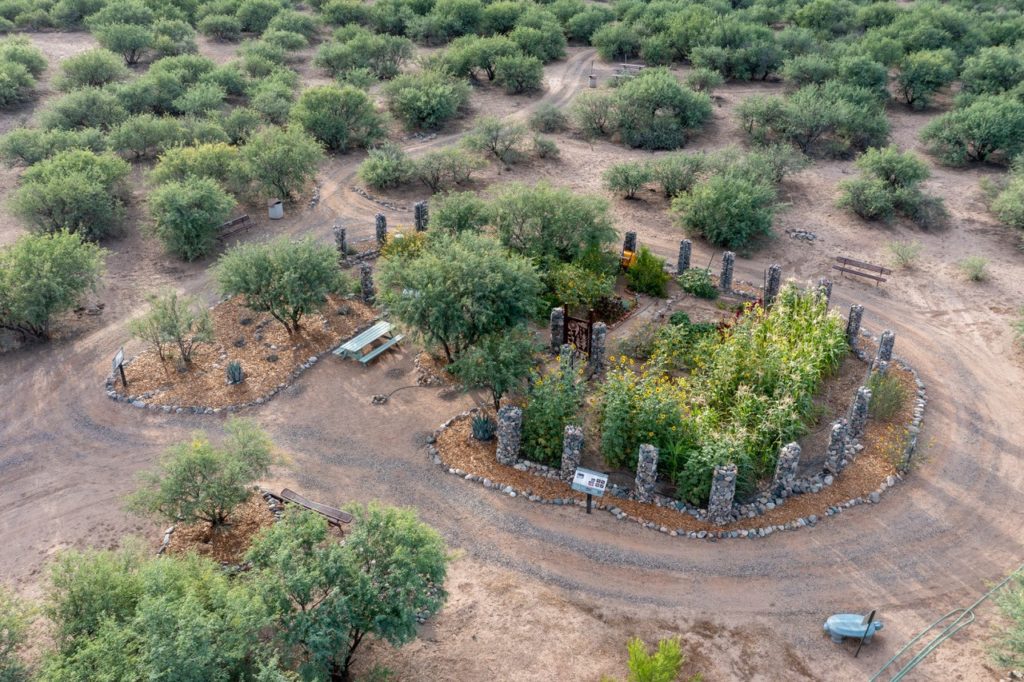On July 2, the Verde Valley Archaeology Center hosted an open house at its Native American Heritage Garden on Homestead Parkway in Camp Verde.
The garden is located on the same site where multiple ancient pit houses were discovered by a developer in 2014, which VVAC excavated free of charge, according to VVAC’s Executive Director, Ken Zoll.
Zoll said that after about a year of excavations [which included the discovery of human remains], the developer decided to donate the land to VVAC.
“He gave us all 15 acres of this pit house village, part of which we sold off to buy the current building that we’re in,” Zoll said, while including that the portion of land that was sold did not contain any of the excavated sites.
At the open house, VVAC staff and volunteers were present to provide information about dry farming and the importance of the “three sisters” [corn, beans and squash].
According to Native Seeds, a nonprofit seed conservation organization, “For many Native American communities, three seeds — corn, beans, and squash represent the most important crops. When planted together, the Three Sisters, work together to help one another thrive and survive. Corn provides tall stalks for the beans to climb so that they are not out-competed by sprawling squash vines. Beans provide nitrogen to fertilize the soil while also stabilizing the tall corn during heavy winds. Beans are nitrogen-fixers meaning they host rhizobia on their roots that can take nitrogen, a much needed plant nutrient, from the air and convert it into forms that can be absorbed by plant roots. The large leaves of squash plants shade the ground which helps retain soil moisture and prevent weeds.”
When visitors arrived to the garden area, they were greeted by VVAC’s Deputy Director, Monica Buckle, who’d brought a cooler of beverages and light snacks to keep everyone fortified in the 100-degree weather.
The visitors meandered along an immaculately-maintained path toward the garden, which included native plants such as cacti and yucca, as well as a variety of petroglyph-inspired rock art created by VVAC volunteer Donna Ullmer.
Ullmer said she has been working at the garden site since “way back, when they were first considering putting the archaeology center out here, years ago.”
Ullmer’s enthusiasm and knowledge about desert gardening were readily apparent during her guided tour around the 1/4 mile loop trail, where she pointed to a variety of plants she has been maintaining.
“In the summer, I generally water once a week, but if we have a good monsoon, you don’t have to worry about it,” she said. “You don’t want to over-water; we all do that in Arizona.”
Ullmer also talked about horned lizards, which are “all over the garden now that we’ve had that there for a few years.”
While no horned lizards made an appearance the day of the open house, visitors could learn about them by stopping at the lifelike horned lizard bench and reading a descriptive plaque detailing their cultural significance to indigenous peoples.

THE VERDE VALLEY ARCHAEOLOGY CENTER’S Native American Heritage Garden is located on Homestead Parkway in Camp Verde and is open from dawn to dusk. Daulton Venglar/Larson Newspapers
In the garden, a variety of plants, including squash, bee plant, sunflower and amaranth were host to a variety of pollinators, who were lazily bumbling about from plant to plant as visitors wandered around, taking in the sights and smells.
VVAC volunteer and ethnobotanist Robert Estrada was also present at the garden, tending to crops of corn, which have been difficult to get going.
Last year, Estrada’s crops died because of a late frost; this year he is more hopeful.
“Farming is a speculative endeavor,” he said. “It’s a learning experience, trial and error.”
Estrada was more proud of the agave garden, which he said is the “most comprehensive, complete agave garden in this part of Arizona.”
“A lot of people aren’t aware of that,” he said.
All of the agave plants, which included four endemic species — Grand Canyon, Tonto Basin, Page Springs and Rimrock — were donated to VVAC by the Desert Botanical Garden in Phoenix.
Estrada takes pleasure in the small things, such as the ants that were collecting wood chips in the agave garden.
“I love watching them,” he said. “I don’t know what they’re doing with the wood chips.”
Ants do not eat agave, but they do “take care of some of the insects that may be harmful to it,” according to Estrada.
Also present in the agave garden were black and orange-colored beetles, which Estrada referred to as “assassin bugs”, as they’re known for feasting upon aphids and corn-eating worms.
Visitors trickled in until about 1 p.m., when the sun’s rays dictated everyone to retreat to cooler climes.
For those that missed the open house, the garden is open every day from dawn til dusk.
Directions to the garden can be found on VVAC’s website.



